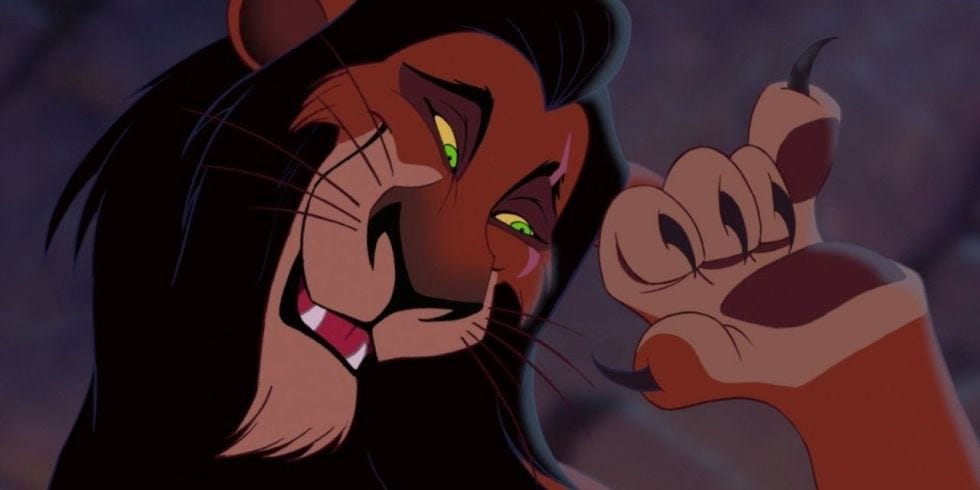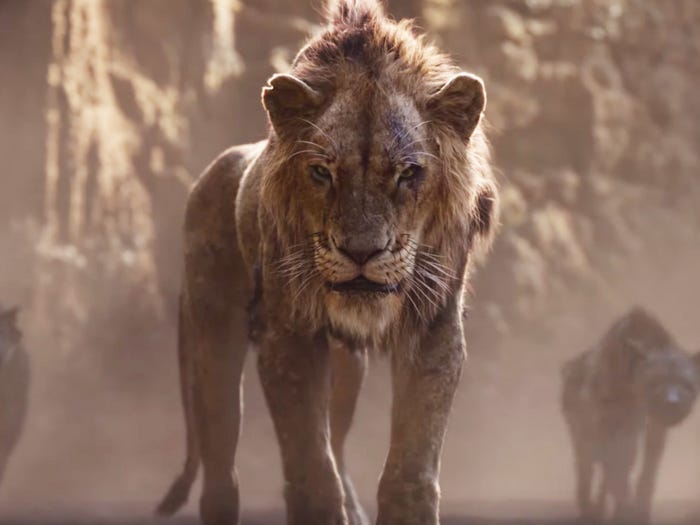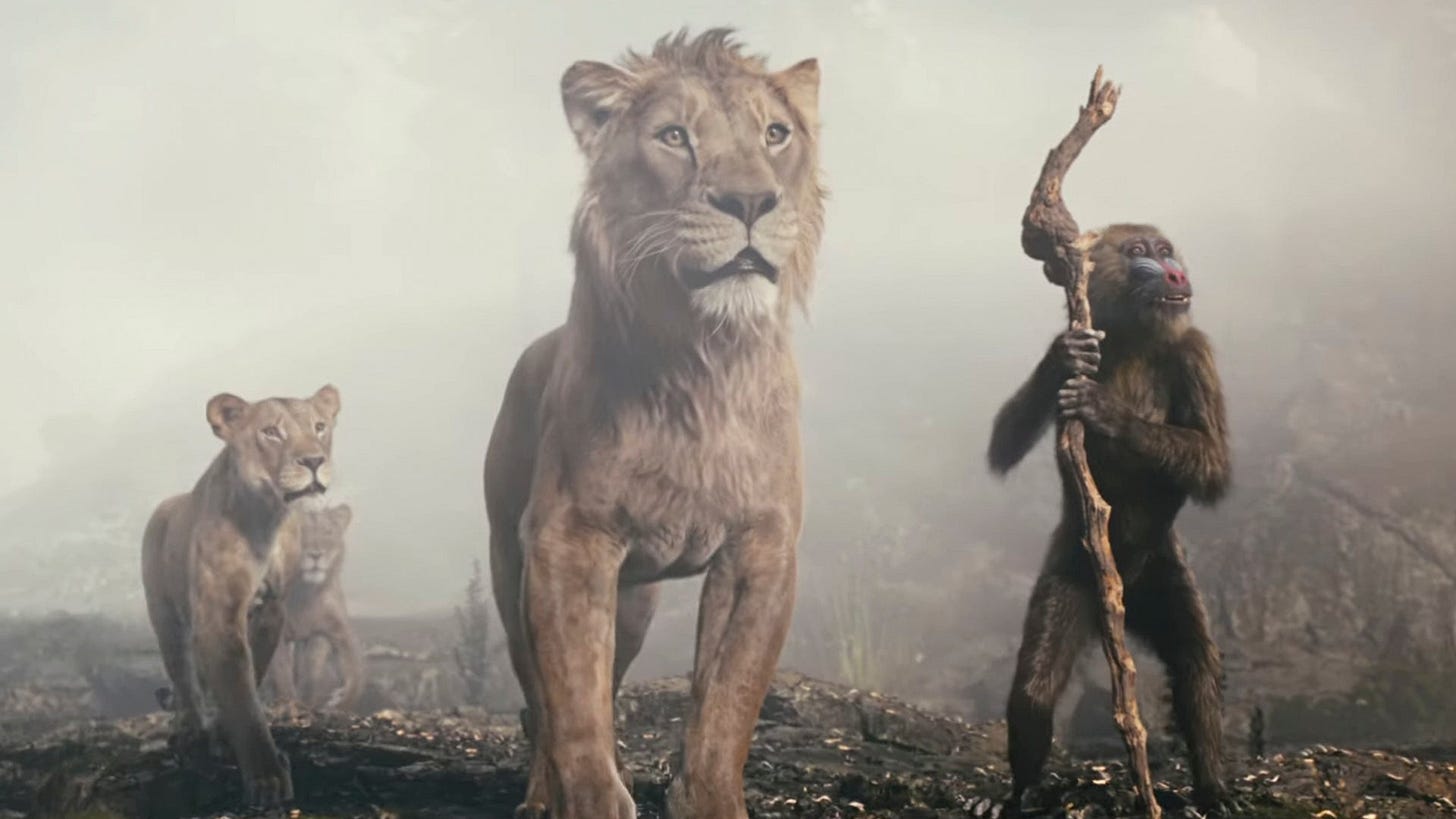Sinful Sunday: The Neutering of Scar and the Evacuation of Queer Subversion in "The Lion King" Franchise
In taking the camp out of the iconic Disney villain, the studio has also vacated what makes him so subversive and so richly compelling.
Hello, dear reader! Do you like what you read here at Omnivorous? Do you like reading fun but insightful takes on all things pop culture? Do you like supporting indie writers? If so, then please consider becoming a subscriber and get the newsletter delivered straight to your inbox. There are a number of paid options, but you can also sign up for free! Every little bit helps. Thanks for reading and now, on with the show!
Welcome to “Sinful Sundays,” where I explore and analyze some of the most notorious queer villains of film and TV (and sometimes literature, depending on my mood). These are the characters that entrance and entertain and revolt us, sometimes all three at the same time. As these queer villains show, very often it’s sweetly good to be bitterly bad.
There are many sins that can be laid at the feet of the live-action remakes that Disney seems intent on forcing upon us every year, but arguably the worst, in my mind at least, is the systematic de-queering of so many of the classic villains. Gone are all of the things that made these characters so eternally delightfull: the color and movement are subdued; the songs are rendered into vignettes as bland as the movies that surround them; the savage glee they take in their torment of the protagonists sanded away. It’s a travesty and, in the mind of this queer critic, a grievous betrayal of everything Disney once stood for.
As I wrote some time ago about the de-queering of Dune’s Baron Harkonnen in the Denis Villeneuve adaptation, it’s not just that we’re losing what makes these characters fun to watch. We’re also losing the very thing that makes them subversive, that gives them that extra little bit of edge that gives queer viewers–particularly younger ones–the chance to feel, at least for a while, that they do have power, even if it must exist outside of the confines of heterosexual closure. Each live-action remake has gone further to neuter and mitigate the queerness of its villains, turning them into the same banal slop as the rest of the films in which they find themselves.
Take, for example, Scar from The Lion King. If there’s one villain that epitomizes queer cunning and queer savagery, it’s Scar. This is a character, after all, who not only murders his own brother in cold blood but seems to delight in doing so and, not content with this, also gaslights his own nephew into believing that he was the one who was responsible for his father’s death. Scar clings to this lie almost to the bitter end, until his hubris gets the better of him and he tells the truth to Simba, only for the young lion to finally find his inner strength and defeat his uncle, leading to the latter’s being devoured by his former hyena allies.
In preparation for this piece I decided to rewatch the 2019 live-action film, in the hopes that I might be able to uncover some residue of the queer malice that made the original character such an inspiration (if I can dare to use that word) for me as a young queer kid constantly existing on the outskirts of heterosexual society. Unfortunately, if unsurprisingly, there was none of that to be found in this new rendition. This film’s Scar, like Jafar and all of the others, has been leached of anything even remotely resembling queerness.
We all know by now that this film lacks almost any semblance of the beauty and the majesty that characterized its animated predecessor. Jon Favreau is many things, but the man is not a particularly inventive visual stylist, and the “live-action” Scar is as washed-out and pale as the rest of the film. In fact, you’d be hard-pressed to even find the scar that gives him his name.
Now, it has to be said that Chiwetel Ejiofor does a very fine vocal performance as Scar. While he may lack Jeremy Irons’ flair for the dramatic and the campy, he does deliver his lines in a suitably stentorian and Shakespearean tone. However, there’s only so much even the most talented actor can do with a script this limp, and to add insult to injury “Be Prepared”--one of the great Disney villain songs of the Renaissance–is bastardized and rendered into a much briefer and less impactful number. Irons may not have been a stellar vocalist, but he was hella campy in his rendition of the song, making the most out of its cutesy rhymes and celebration of ambition and evil.
But let’s pause for a moment on that question of camp, since this seems to be the thing that many commentators have focused on when they discuss the shift from Renaissance Disney to…whatever Disney is these days. Obviously camp means different things to different people, but it is fundamentally about artifice and subversion and, when it comes to gender and queerness, it’s about pointing out how the supposedly fixed nature of such things is itself a fiction. Straightness and normative gender roles are as subject to ridicule and mockery as anything else.
That being the case, it’s easy to see how queer villains should serve as points of opposition and subversion within the rigid binaries set up by so many Disney films. Scar–and Ursula, and Jafar, and Gaston, and all of the others–are compelling and fascinating not because they might sleep with others of the same sex but, instead, because their very existence calls into question the heterosexist and deeply patriarchal logic that so often undergirds the Disney animated features canon. This obviously has a lot of appeal for queer folks, both old and young alike, but I daresay that it’s also refreshing for even straight audiences to have an outlet for some of their latent queer yearnings, to say nothing of their desire to escape the straitjacket of heterosexuality.
Thus, it’s not just that the new Scar is more boring and less camp than his animated predecessor. It’s also that he lacks the bite that made this swishy lion with the dark mane and the limp wrist–er, paw–so fascinating and fun and, more to the point, troubling to watch. As viewers we find ourselves compelled by Scar even as we’re also revolted by his actions, particularly the joy he takes in murdering Mufasa (Irons’ whisper of “long live the king” is something that will live in my mind forever).
In the new version of The Lion King, by contrast, the photorealism of the animation and the much “straighter” vocal performance renders Scar into a much more straightforward representation of evil. It’s easier to put him away, to forego any sense of identification with or enjoyment of his presence. Even his murder of Mufasa is a much more muted affair than in the 1994 version, and the new Scar seems to be going through the motions of usurpation rather than, say, actually savoring his triumph. That’s not very queer, is it?
If, like me, you had any hope that the new film Mufasa would work to restore at least a scintilla of the queerness that we once associated with this beloved queer villain, I’m sorry to disappoint you. In fact, this new film goes out of its way to remove even the barest traces of queerness from Scar’s diegetic persona. Most importantly, he falls in love with Sarabi, despite the fact that she doesn’t seem inclined to give him the time of day. This entire subplot is drawn from the 2019 The Lion King, in which Scar is particularly insistent that the widowed queen join him, despite her giving absolutely no indication that she wishes to do so. It’s all a bit heavy-handed and unconvincing, and it’s doubly so in Mufasa. In fact, if there’s one character in the latter film that has anything remotely resembling the queer affect of Scar it would be Kiros, voiced with sinister charm by Mads Mikkelsen (no stranger himself to playing queer villains).
In the end, I found myself both deeply frustrated and very disappointed with how badly these new iterations of Scar failed to live up to even the barest of expectations. As one author put it, Scar should really be gayer, and we’re all the poorer for it when he isn’t. The queer Disney villain appears to be a thing of the past but, so long as those old films exist, they will too, a fascinating and alluring reminder of the pleasures of queer evil.






